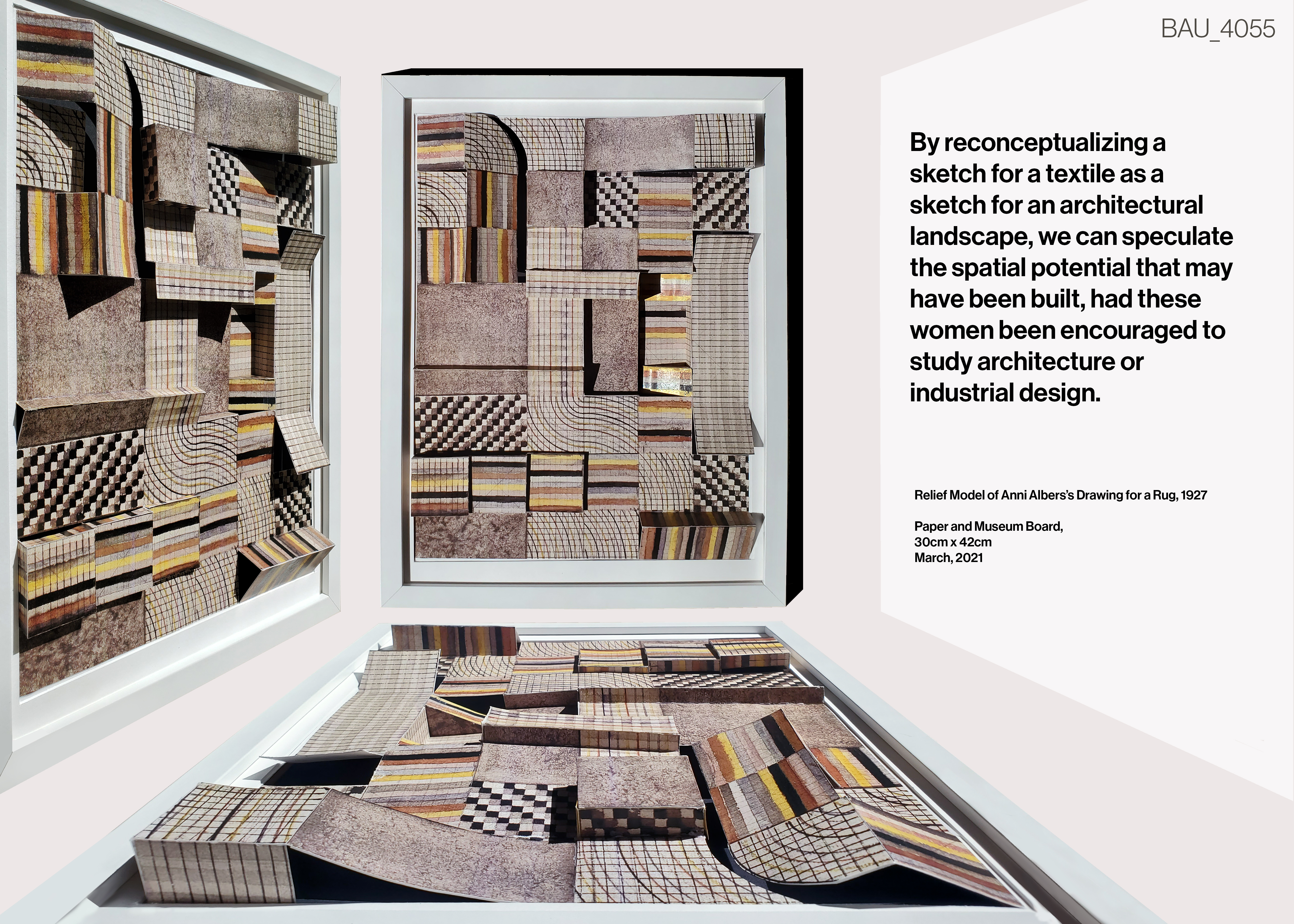*Shortlisted in Atuminate’s Bauhaus Design Style Competition, 2021
Creating Depth for those Who Could Not:
An Hommage to the Weaving Women of the Bauhaus
An Hommage to the Weaving Women of the Bauhaus
Before the Bauhaus, women in Germany had little to no options for studying art and
architecture. The Bauhaus in 1919 falsely promised equal opportunities and chances for men and
women. Walter Gropius would say they accepted “any person of good repute, regardless of age
or sex.” (1919) He said this, while famously believing that men and women’s brains operated
differently––specifically, men had the capacity to think in three dimensions while women did
not.1 The Bauhaus’s imbalanced pedagogy discouraged women from studying fields of the third
dimension such as architecture, industrial design, and ceramics. Despite being one of the
Bauhaus’s most successful departments in a time of economic hardship, the weaving women
were blatantly excluded from the recognized group of mainstream artists or designers.
“Gertrud Arndt, who entered the weaving workshop reluctantly in 1924 after coming to the Bauhaus in 1923 with the hope of pursuing architectural training under Gropius. But given that the Bauhaus only advanced a small clique of men through the construction course [...] and that she was a woman thwarted her initial ambitions”2“I never wanted to weave… No, not at all. All those threads, I didn’t want that.”
Unable to explore space and form, the weavers embodied the Bauhaus’s functionalist rhetoric through a profound understanding of the loom and its functional (and profitable) applications. Aligning with Bauhaus principles, Anni Albers and Gunta Stölzl declared that the way toward mass production must come through an understanding of the craft. Becoming masters of the loom, these women proposed a future of mass textile production, through experimentation.3
Although their textiles in many ways had architectural implications, the Bauhaus weavers were never able to explore space through their craft. Weaving became a vehicle for individual design explorations and sensibilities, which had to be flattened and restrained to the limits of the loom. This inquiry into a Bauhaus weaver’s design sensibility begs us to ask the question, “If these artists and designers would have been allowed to experiment and study within the third dimension, what could have been their contribution to the built environment and the Modern Functional Building?”
“Gertrud Arndt, who entered the weaving workshop reluctantly in 1924 after coming to the Bauhaus in 1923 with the hope of pursuing architectural training under Gropius. But given that the Bauhaus only advanced a small clique of men through the construction course [...] and that she was a woman thwarted her initial ambitions”2“I never wanted to weave… No, not at all. All those threads, I didn’t want that.”
Unable to explore space and form, the weavers embodied the Bauhaus’s functionalist rhetoric through a profound understanding of the loom and its functional (and profitable) applications. Aligning with Bauhaus principles, Anni Albers and Gunta Stölzl declared that the way toward mass production must come through an understanding of the craft. Becoming masters of the loom, these women proposed a future of mass textile production, through experimentation.3
Although their textiles in many ways had architectural implications, the Bauhaus weavers were never able to explore space through their craft. Weaving became a vehicle for individual design explorations and sensibilities, which had to be flattened and restrained to the limits of the loom. This inquiry into a Bauhaus weaver’s design sensibility begs us to ask the question, “If these artists and designers would have been allowed to experiment and study within the third dimension, what could have been their contribution to the built environment and the Modern Functional Building?”




1 Mariángeles García. “The Lost History of the Women of the Bauhaus “ [Las mujeres olvidadas de la Bauhaus] 22 May 2018. ArchDaily. (Trans. Gosselin, Marina) Accessed 29 Mar 2021.
2 Smith, T’ai. “TOWARD A MODERNIST THEORY OF WEAVING: THE USE OF TEXTILES IN ARCHITECTURAL SPACE.” In Bauhaus Weaving Theory: From Feminine Craft to Mode of Design, 41-78. University of Minnesota Press, 2014. Accessed March 29, 2021. http://www.jstor.org/stable/10.5749/j.ctt9qh311.6.
3 Smith, T’ai. “TOWARD A MODERNIST THEORY OF WEAVING: THE USE OF TEXTILES IN ARCHITECTURAL SPACE.” In Bauhaus Weaving Theory: From Feminine Craft to Mode of Design, 41-78. University of Minnesota Press, 2014. Accessed March 29, 2021. http://www.jstor.org/stable/10.5749/j.ctt9qh311.6.